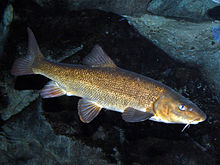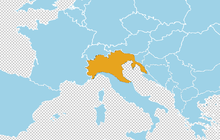| Italian barbel | |
|---|---|

| |
|
Scientific classification
| |
| Domain: | Eukaryota |
| Kingdom: | Animalia |
| Phylum: | Chordata |
| Class: | Actinopterygii |
| Order: | Cypriniformes |
| Family: | Cyprinidae |
| Subfamily: | Barbinae |
| Genus: | Barbus |
| Species: | B. plebejus
|
| Binomial name | |
| Barbus plebejus
Bonaparte, 1839
| |

| |
The Italian barbel (Barbus plebejus) is a species of freshwater fish in the family Cyprinidae, nearly related to the common barbel Barbus barbus. The name barbel derived from the Latin barba, meaning beard, a reference to the two pairs of barbels, a longer pair pointing forwards and slightly down positioned, on the side of the mouth.
Description
Barbus plebejus can reach a maximum length of 70 cm (28 in) in males and a maximum weight of 6 kilograms (13 lb). Usually, it is much smaller. It has a long and slender body, with a mouth equipped with characteristic four barbels (hence the common and genus names). It has greenish back with black dots, sides finely dotted, whitish belly, paired fins tinged with grey and a slightly thorny dorsal ray. Lower lip has a median lobe.
Distribution
The species is found in Croatia, Italy, Slovenia and Switzerland.
Habitat
Like the common barbel, these long-lived fishes have their natural habitats in running waters of rivers and rarely freshwater lakes. They inhabit the water just above the bottom ( benthopelagic), feeding on benthic invertebrates, small fish and algae. They also migrate within freshwater ( potamodromous), for spawning purposes. It is not considered a threatened species by the IUCN. [1]
References
- ^ a b Freyhof, J. (2020) [errata version of 2011 assessment]. "Barbus plebejus". IUCN Red List of Threatened Species. 2011: e.T2568A174777197. doi: 10.2305/IUCN.UK.2011-1.RLTS.T2568A174777197.en. Retrieved 3 January 2024.
- Helfman, G., B. Collette i D. Facey: The diversity of fishes. Blackwell Science, Malden, Massachusetts, United States, 1997.
- Moyle, P. i J. Cech.: Fishes: An Introduction to Ichthyology, 4th ed., Upper Saddle River, New Jersey (United States): Prentice-Hall. Any 2000.
- Nelson, J.: Fishes of the World, 3rd. Ed. New York (United States): John Wiley and Sons. Any 1994.
- Wheeler, A.: The World Encyclopedia of Fishes, 2nd ed., London: Macdonald. Any 1985.
Mitochondrial phylogeny and taxonomic revision of Italian and Slovenian fluvio-lacustrine barbels, Barbus sp. (Cypriniformes, Cyprinidae). (n.d.). https://bmczool.biomedcentral.com/articles/10.1186/s40850-021-00073
External links
- Froese, Rainer; Pauly, Daniel (eds.) (2006). "Barbus plebejus" in FishBase. April 2006 version.
| Italian barbel | |
|---|---|

| |
|
Scientific classification
| |
| Domain: | Eukaryota |
| Kingdom: | Animalia |
| Phylum: | Chordata |
| Class: | Actinopterygii |
| Order: | Cypriniformes |
| Family: | Cyprinidae |
| Subfamily: | Barbinae |
| Genus: | Barbus |
| Species: | B. plebejus
|
| Binomial name | |
| Barbus plebejus
Bonaparte, 1839
| |

| |
The Italian barbel (Barbus plebejus) is a species of freshwater fish in the family Cyprinidae, nearly related to the common barbel Barbus barbus. The name barbel derived from the Latin barba, meaning beard, a reference to the two pairs of barbels, a longer pair pointing forwards and slightly down positioned, on the side of the mouth.
Description
Barbus plebejus can reach a maximum length of 70 cm (28 in) in males and a maximum weight of 6 kilograms (13 lb). Usually, it is much smaller. It has a long and slender body, with a mouth equipped with characteristic four barbels (hence the common and genus names). It has greenish back with black dots, sides finely dotted, whitish belly, paired fins tinged with grey and a slightly thorny dorsal ray. Lower lip has a median lobe.
Distribution
The species is found in Croatia, Italy, Slovenia and Switzerland.
Habitat
Like the common barbel, these long-lived fishes have their natural habitats in running waters of rivers and rarely freshwater lakes. They inhabit the water just above the bottom ( benthopelagic), feeding on benthic invertebrates, small fish and algae. They also migrate within freshwater ( potamodromous), for spawning purposes. It is not considered a threatened species by the IUCN. [1]
References
- ^ a b Freyhof, J. (2020) [errata version of 2011 assessment]. "Barbus plebejus". IUCN Red List of Threatened Species. 2011: e.T2568A174777197. doi: 10.2305/IUCN.UK.2011-1.RLTS.T2568A174777197.en. Retrieved 3 January 2024.
- Helfman, G., B. Collette i D. Facey: The diversity of fishes. Blackwell Science, Malden, Massachusetts, United States, 1997.
- Moyle, P. i J. Cech.: Fishes: An Introduction to Ichthyology, 4th ed., Upper Saddle River, New Jersey (United States): Prentice-Hall. Any 2000.
- Nelson, J.: Fishes of the World, 3rd. Ed. New York (United States): John Wiley and Sons. Any 1994.
- Wheeler, A.: The World Encyclopedia of Fishes, 2nd ed., London: Macdonald. Any 1985.
Mitochondrial phylogeny and taxonomic revision of Italian and Slovenian fluvio-lacustrine barbels, Barbus sp. (Cypriniformes, Cyprinidae). (n.d.). https://bmczool.biomedcentral.com/articles/10.1186/s40850-021-00073
External links
- Froese, Rainer; Pauly, Daniel (eds.) (2006). "Barbus plebejus" in FishBase. April 2006 version.
